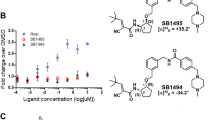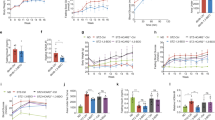Abstract
PPARγ is the functioning receptor for the thiazolidinedione (TZD) class of antidiabetes drugs including rosiglitazone and pioglitazone1. These drugs are full classical agonists for this nuclear receptor, but recent data have shown that many PPARγ-based drugs have a separate biochemical activity, blocking the obesity-linked phosphorylation of PPARγ by Cdk5 (ref. 2). Here we describe novel synthetic compounds that have a unique mode of binding to PPARγ, completely lack classical transcriptional agonism and block the Cdk5-mediated phosphorylation in cultured adipocytes and in insulin-resistant mice. Moreover, one such compound, SR1664, has potent antidiabetic activity while not causing the fluid retention and weight gain that are serious side effects of many of the PPARγ drugs. Unlike TZDs, SR1664 also does not interfere with bone formation in culture. These data illustrate that new classes of antidiabetes drugs can be developed by specifically targeting the Cdk5-mediated phosphorylation of PPARγ.
This is a preview of subscription content, access via your institution
Access options
Subscribe to this journal
Receive 51 print issues and online access
$199.00 per year
only $3.90 per issue
Buy this article
- Purchase on Springer Link
- Instant access to full article PDF
Prices may be subject to local taxes which are calculated during checkout




Similar content being viewed by others
References
Lehmann, J. M. et al. An antidiabetic thiazolidinedione is a high affinity ligand for peroxisome proliferator-activated receptor γ (PPARγ). J. Biol. Chem. 270, 12953–12956 (1995)
Choi, J. H. et al. Anti-diabetic drugs inhibit obesity-linked phosphorylation of PPARγ by Cdk5. Nature 466, 451–456 (2010)
Tontonoz, P., Hu, E. & Spiegelman, B. M. Stimulation of adipogenesis in fibroblasts by PPARγ2, a lipid-activated transcription factor. Cell 79, 1147–1156 (1994)
Willson, T. M., Lambert, M. H. & Kliewer, S. A. Peroxisome proliferator-activated receptor gamma and metabolic disease. Annu. Rev. Biochem. 70, 341–367 (2001)
Forman, B. M. et al. 15-Deoxy-Δ12,14-prostaglandin J2 is a ligand for the adipocyte determination factor PPARγ. Cell 83, 803–812 (1995)
Henke, B. R. et al. N-(2-Benzoylphenyl)-l-tyrosine PPARγ agonists. 1. Discovery of a novel series of potent antihyperglycemic and antihyperlipidemic agents. J. Med. Chem. 41, 5020–5036 (1998)
Parulkar, A. A., Pendergrass, M. L., Granda-Ayala, R., Lee, T. R. & Fonseca, V. A. Nonhypoglycemic effects of thiazolidinediones. Ann. Intern. Med. 134, 61–71 (2001)
Kahn, S. E. et al. Rosiglitazone-associated fractures in type 2 diabetes. Diabetes Care 31, 845–851 (2008)
Nesto, R. W. et al. Thiazolidinedione use, fluid retention, and congestive heart failure: a consensus statement from the American Heart Association and American Diabetes Association. Diabetes Care 27, 256–263 (2004)
Rocchi, S. et al. A unique PPARγ ligand with potent insulin-sensitizing yet weak adipogenic activity. Mol. Cell 8, 737–747 (2001)
Berger, J. P. et al. Distinct properties and advantages of a novel peroxisome proliferator-activated protein γ selective modulator. Mol. Endocrinol. 17, 662–676 (2003)
Lamotte, Y. et al. Synthesis and biological activities of novel indole derivatives as potent and selective PPARγ modulators. Bioorg. Med. Chem. Lett. 20, 1399–1404 (2010)
Grana, X. et al. PITALRE, a nuclear CDC2-related protein kinase that phosphorylates the retinoblastoma protein in vitro. Proc. Natl Acad. Sci. USA 91, 3834–3838 (1994)
Kliewer, S. A. et al. A prostaglandin J2 metabolite binds peroxisome proliferator-activated receptor γ and promotes adipocyte differentiation. Cell 83, 813–819 (1995)
Chawla, A., Schwarz, E. J., Dimaculangan, D. D. & Lazar, M. A. Peroxisome proliferator-activated receptor (PPAR) gamma: adipose-predominant expression and induction early in adipocyte differentiation. Endocrinology 135, 798–800 (1994)
Grey, A. et al. The peroxisome proliferator-activated receptor-gamma agonist rosiglitazone decreases bone formation and bone mineral density in healthy postmenopausal women: a randomized, controlled trial. J. Clin. Endocrinol. Metab. 92, 1305–1310 (2007)
Lecka-Czernik, B. et al. Inhibition of Osf2/Cbfa1 expression and terminal osteoblast differentiation by PPARγ2. J. Cell. Biochem. 74, 357–371 (1999)
Bruning, J. B. et al. Partial agonists activate PPARγ using a helix 12 independent mechanism. Structure 15, 1258–1271 (2007)
Hamuro, Y. et al. Hydrogen/deuterium-exchange (H/D-Ex) of PPARγ LBD in the presence of various modulators. Protein Sci. 15, 1883–1892 (2006)
Nolte, R. T. et al. Ligand binding and co-activator assembly of the peroxisome proliferator-activated receptor-γ. Nature 395, 137–143 (1998)
Chalmers, M. J., Busby, S. A., Pascal, B. D., Southern, M. R. & Griffin, P. R. A two-stage differential hydrogen deuterium exchange method for the rapid characterization of protein/ligand interactions. J. Biomol. Tech. 18, 194–204 (2007)
DeFronzo, R. A., Tobin, J. D. & Andres, R. Glucose clamp technique: a method for quantifying insulin secretion and resistance. Am. J. Physiol. 237, E214–E223 (1979)
Flier, J. S., Cook, K. S., Usher, P. & Spiegelman, B. M. Severely impaired adipsin expression in genetic and acquired obesity. Science 237, 405–408 (1987)
Hu, E., Liang, P. & Spiegelman, B. M. AdipoQ is a novel adipose-specific gene dysregulated in obesity. J. Biol. Chem. 271, 10697–10703 (1996)
Kahn, B. B. & McGraw, T. E. Rosiglitazone, PPARγ, and type 2 diabetes. N. Engl. J. Med. 363, 2667–2669 (2010)
Nolan, J. J., Ludvik, B., Beerdsen, P., Joyce, M. & Olefsky, J. Improvement in glucose tolerance and insulin resistance in obese subjects treated with troglitazone. N. Engl. J. Med. 331, 1188–1193 (1994)
Hamuro, Y. et al. Hydrogen/deuterium-exchange (H/D-Ex) of PPARγ LBD in the presence of various modulators. Protein Sci. 15, 1883–1892 (2006)
Mayerson, A. B. et al. The effects of rosiglitazone on insulin sensitivity, lipolysis, and hepatic and skeletal muscle triglyceride content in patients with type 2 diabetes. Diabetes 51, 797–802 (2002)
Kim, H. J. et al. Differential effects of interleukin-6 and -10 on skeletal muscle and liver insulin action in vivo. Diabetes 53, 1060–1067 (2004)
Acknowledgements
We are grateful for support from S. Novick for assistance in the HDX studies and from R. D. Garcia-Ordonez in protein production and mutagenesis. We are grateful for support from B. Pascal and S. Willis for software analysing the HDX data. We are grateful to R. Gupta and P. Cohen for their critical comments on the manuscript. This work was supported in part by the Intramural Research Program of the National Institutes of Health (NIH), National Institute of Mental Health (grant U54-MH074404, H. Rosen principal investigator), the National Institute of General Medical Sciences (grant R01-GM084041, P.R.G.) and the National Institute of Diabetes and Digestive and Kidney Diseases (grant 1RC4DK090861, B.M.S.). This work also supported by NIH DK31405 to B.M.S.
Author information
Authors and Affiliations
Contributions
B.M.S. and P.R.G. conceived the project and designed research; J.H.C., A.S.B., T.M.K., S.A.B., M.J.C., N.K., D.S.K., Y.S., Y.H., J.B.B., D.P.M., M.D.C., D.L., M.J.J., S.C.S., and D.V. performed research; J.H.C., A.S.B., T.M.K., S.A.B., M.J.C., N.K., D.K., J.B.B., D.M., M.D.C., D.L., M.J.J., S.C.S., D.V., G.I.S., B.M.S and P.R.G. analysed data; and B.M.S., A.S.B. and P.R.G. wrote the paper with contributions from all authors.
Corresponding authors
Ethics declarations
Competing interests
The authors declare no competing financial interests.
Supplementary information
Supplementary Information
This file contains Supplementary Figures 1-8 with legends and Supplementary Table 1. (PDF 540 kb)
Rights and permissions
About this article
Cite this article
Choi, J., Banks, A., Kamenecka, T. et al. Antidiabetic actions of a non-agonist PPARγ ligand blocking Cdk5-mediated phosphorylation. Nature 477, 477–481 (2011). https://doi.org/10.1038/nature10383
Received:
Accepted:
Published:
Issue Date:
DOI: https://doi.org/10.1038/nature10383
This article is cited by
-
Blockage of PPARγ T166 phosphorylation enhances the inducibility of beige adipocytes and improves metabolic dysfunctions
Cell Death & Differentiation (2023)
-
BEX1 supports the stemness of hepatoblastoma by facilitating Warburg effect in a PPARγ/PDK1 dependent manner
British Journal of Cancer (2023)
-
3-Hydroxybutyrate ameliorates insulin resistance by inhibiting PPARγ Ser273 phosphorylation in type 2 diabetic mice
Signal Transduction and Targeted Therapy (2023)
-
Advances in Studies of Chiglitazar Sodium, a Novel PPAR Pan-Agonist, for the Treatment of Type 2 Diabetes Mellitus
Current Medical Science (2023)
-
The nuclear cytokine IL-37a controls lethal cytokine storms primarily via IL-1R8-independent transcriptional upregulation of PPARγ
Cellular & Molecular Immunology (2023)
Comments
By submitting a comment you agree to abide by our Terms and Community Guidelines. If you find something abusive or that does not comply with our terms or guidelines please flag it as inappropriate.



